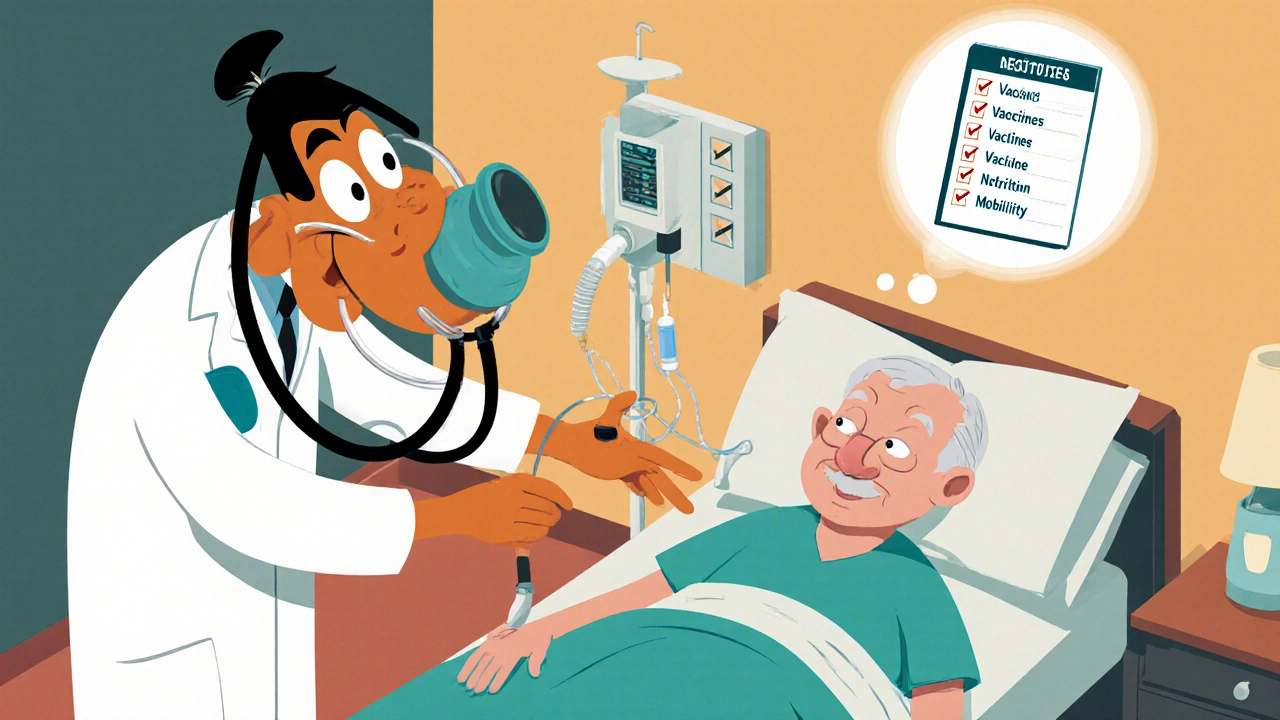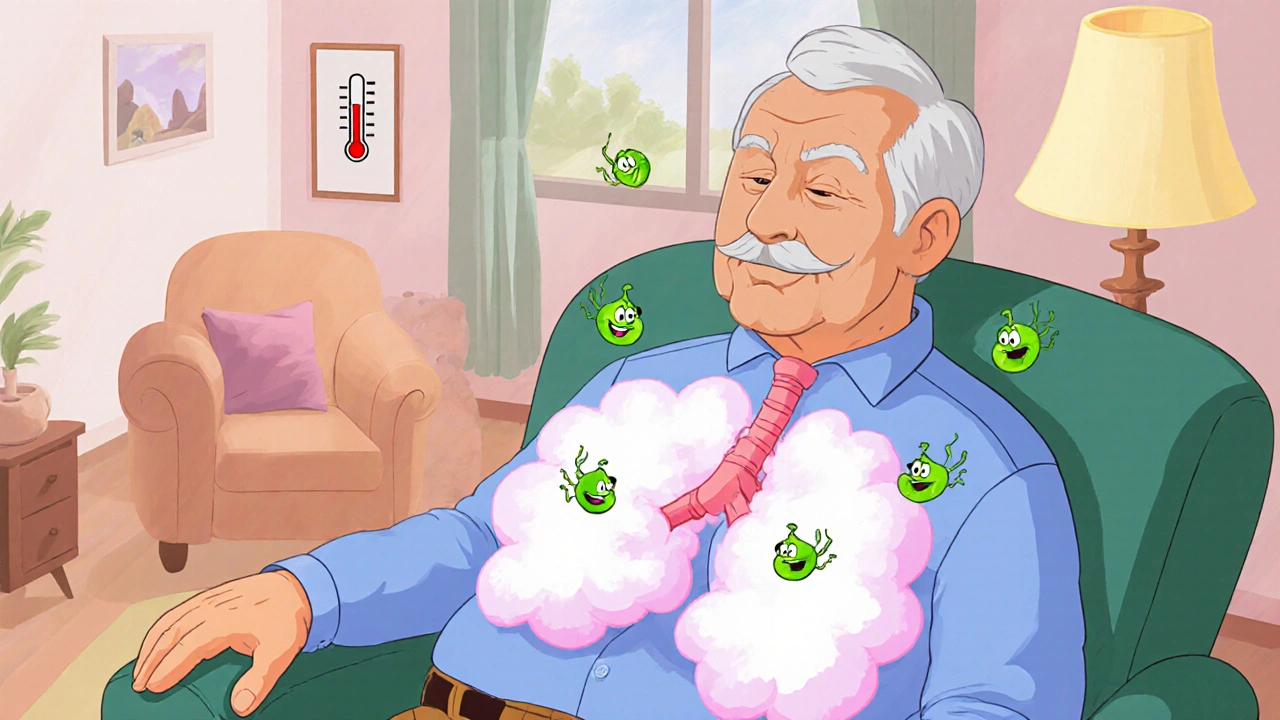Elderly Pneumonia Risk Assessment Tool
CURB-65 Assessment Tool
Use this clinical scoring system to determine hospital admission risk for elderly patients with pneumonia.
Based on 2024 guidelines: Score ≥2 typically warrants hospitalization.
Risk Assessment Results
When you hear the word Pneumonia is a lung infection that inflames the air sacs, filling them with fluid or pus, and causing cough, fever, and shortness of breath, you might picture anyone catching a cold. But for people over 65, pneumonia becomes a life‑threatening event that often lands them in hospital.
Why Older Adults Are More Vulnerable
Age‑related changes in the immune system-known as Immune senescence the gradual decline of immune function with aging-mean the body can’t fight off invading microbes as efficiently. Add chronic conditions like Chronic obstructive pulmonary disease a progressive lung disease that blocks airflow and makes breathing difficult or heart failure, and the risk spikes dramatically.
Other risk factors that stack up in later life include:
- Reduced cough reflex, leading to Aspiration inhalation of food, saliva, or gastric contents into the lungs, which seeds bacteria.
- Living in crowded settings such as nursing homes, where Hospital‑acquired pneumonia pneumonia contracted after admission to a health‑care facility spreads easily.
- Smoking history, which damages airway cilia and impairs clearance of pathogens.
- Malnutrition, weakening overall resistance.
Common Causative Pathogens
Not all pneumonia is created equal. In the elderly, the most frequent bacterial culprit is Streptococcus pneumoniae a gram‑positive bacterium responsible for classic community‑acquired pneumonia. Viral agents, especially Influenza the flu virus, which can damage lung tissue and predispose to secondary bacterial infection, are also common triggers. Fungal pneumonias, though rarer, appear in immunocompromised seniors.
Prevention Strategies That Really Work
Prevention isn’t about a single magic bullet; it’s a bundle of habits, vaccinations, and environmental controls.
Vaccination Schedule
The two most important vaccines for older adults are the pneumococcal and influenza shots. Below is a quick comparison of the two main pneumococcal options.
| Vaccine | Type | Coverage | Recommended Age |
|---|---|---|---|
| PCV13 (Prevnar 13) | Conjugate | 13 serotypes, strong immune response | 65+ (single dose) |
| PPSV23 (Pneumovax 23) | Polysaccharide | 23 serotypes, broader coverage | 65+ (single dose, booster after 5 years if needed) |
Current guidelines (2024 Australian Immunisation Handbook) suggest a one‑time PCV13 followed by PPSV23 at least eight weeks later, then a booster of PPSV23 every five years for high‑risk seniors.
Influenza Vaccination
The Influenza vaccine annual flu shot that protects against the most common circulating strains should be administered before the respiratory season starts, typically in March or April in the Southern Hemisphere.
Lifestyle Modifications
- Quit smoking - the risk of pneumonia drops by nearly 40% within a year of cessation.
- Stay active - moderate exercise improves lung capacity and immune function.
- Maintain a balanced diet rich in protein, vitamins C and D - nutrients that support immune health.
- Hand hygiene - regular washing reduces exposure to respiratory pathogens.
- Oral care - good dental hygiene lowers the chance of aspirating bacteria from the mouth.
Recognizing Early Signs
Older adults often present atypically. Instead of a high fever, they might show confusion, loss of appetite, or a sudden decline in mobility. Common red flags include:
- New or worsening cough, especially with sputum that is yellow, green, or rusty.
- Rapid breathing or shortness of breath at rest.
- Chest pain that worsens with deep breaths.
- Low‑grade fever (≥37.5°C) or, paradoxically, no fever at all.
- Altered mental status - delirium can be the first clue.
If any of these appear, seek medical attention promptly. Early diagnosis often means oral antibiotics can be started at home, avoiding hospitalization.
Treatment Pathways
Treatment hinges on severity, causative organism, and comorbidities.
Outpatient Management
For mild to moderate community‑acquired pneumonia (CAP) without severe breathlessness, doctors typically prescribe a Antibiotic a drug that kills or stops growth of bacteria regimen such as amoxicillin+doxycycline for 5-7 days. Follow‑up chest X‑ray after 2 weeks confirms resolution.
Hospital Admission Criteria
Use the CURB‑65 scoring system (Confusion, Urea, Respiratory rate, Blood pressure, age≥65) to decide. A score of 2 or more usually warrants inpatient care.
In‑patient Care
IV antibiotics (e.g., ceftriaxone plus azithromycin) are started immediately, then de‑escalated based on sputum cultures. Supplemental oxygen, bronchodilators, and physiotherapy help maintain lung expansion. Severe cases may need non‑invasive ventilation or ICU support.
Addressing Underlying Issues
Treating the pneumonia alone isn’t enough. Manage chronic conditions-optimize COPD inhalers, control heart failure, and correct anemia. Nutritional support and early mobilization speed recovery.

Common Pitfalls to Avoid
- Delaying antibiotics - every hour counts in the elderly.
- Relying on fever alone - many seniors are afebrile.
- Skipping vaccine boosters - immunity wanes after five years.
- Neglecting oral care - poor dentition fuels aspiration pneumonia.
- Ignoring polypharmacy interactions - some drugs blunt cough reflex.
Quick Checklist for Caregivers
- Verify latest PCV13/PPSV23 and flu shots.
- Monitor temperature, breathing rate, and mental clarity daily.
- Encourage fluid intake and upright positioning after meals.
- Keep a list of current medications and allergies for the doctor.
- Arrange prompt medical review if cough worsens or confusion appears.
Frequently Asked Questions
How soon after a flu shot can an elderly person still get pneumonia?
The flu vaccine doesn’t prevent bacterial pneumonia directly, but it reduces the chance of a flu infection that can lead to secondary bacterial pneumonia. Even if a senior gets the flu, prompt antiviral treatment and good supportive care lower the risk of progressing to pneumonia.
Can pneumonia be cured without antibiotics?
Viral pneumonia (e.g., caused by influenza) may resolve with supportive care alone, but bacterial pneumonia almost always requires antibiotics. Untreated bacterial infection can rapidly become fatal in older adults.
Is it safe for a nursing‑home resident to receive both PCV13 and PPSV23?
Yes. The recommended schedule separates the two doses by at least eight weeks, then gives a PPSV23 booster after five years for high‑risk individuals. The combined protection covers the most common serotypes.
What home signs suggest a pneumonia relapse after discharge?
Re‑emergence of cough with colored sputum, fever over 38°C, shortness of breath, or a sudden drop in energy levels should trigger a call to the GP. Chest X‑ray may be needed to rule out a new infection.
Do vitamin D supplements help prevent pneumonia?
Observational studies link low vitamin D levels with higher respiratory infection rates, and supplementation to 800‑1000IU daily modestly reduces risk, especially in winter months. It’s a useful adjunct but not a replacement for vaccines.
By staying aware of risk factors, keeping vaccinations up to date, and acting fast at the first sign of trouble, families can dramatically lower the chances that pneumonia becomes a deadly episode for their older loved ones.





Lauren Sproule
October 17, 2025 AT 12:53hey guys im really glad u shared this it’s super useful for caretakers and families who want to keep seniors safe keep doing the great work
CHIRAG AGARWAL
October 31, 2025 AT 23:07Honestly this post is just a bunch of textbook fluff not much new for anyone
Carissa Padilha
November 15, 2025 AT 10:20I read this article and felt a strange déjà vu, as if hidden agendas are being disguised as medical advice.
The pharma giants love to push vaccines and antibiotics while quietly funding research that keeps the public dependent.
Did you know that many of the so‑called ‘high‑risk’ seniors are actually part of a data collection program for future gene‑editing trials?
The timing of the flu shot recommendations always coincides with the rollout of new antiviral patents that line the pockets of big pharma.
And the emphasis on oral antibiotics ignores the fact that natural immunity can be strengthened by sunlight, fresh air, and fermented foods.
I’ve seen patients who avoided the standard shots and survived with home‑made herbal teas and regular brisk walks.
Meanwhile, the guidelines keep changing, which makes me suspect that the numbers are being tweaked by lobbyists.
The table comparing PCV13 and PPSV23 looks clean, but it hides the fact that the newer conjugate vaccine contains adjuvants that have been linked to autoimmune flare‑ups.
There’s also a silent clause about ‘high‑risk’ individuals that actually includes anyone who can be tracked through electronic health records.
In my experience, the best defense is critical thinking and keeping a journal of symptoms rather than relying on a quick jab.
If you look at the mortality charts from the last decade, you’ll notice a spike in hospital admissions right after major vaccination campaigns.
That isn’t a coincidence, it’s a pattern that the mainstream media refuses to discuss.
I advise anyone reading this to question who benefits the most from the push for universal vaccination in the elderly.
The real culprits behind pneumonia are often environmental toxins, poor indoor air quality, and stress, not just a lack of shots.
Stay vigilant, do your own research, and don’t be afraid to challenge the official narrative.
Richard O'Callaghan
November 29, 2025 AT 21:33I think youre missing the point the vaccines actually save lives and this article is spot on
Alexis Howard
December 14, 2025 AT 08:47Another thing the article ignores is that most seniors can handle a cold without any meds